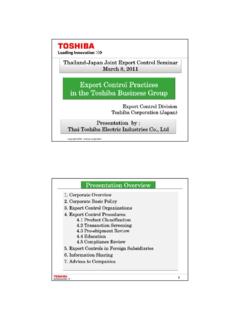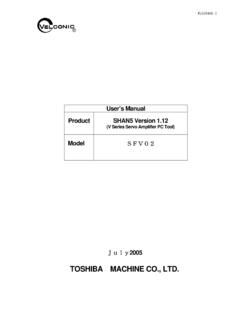Transcription of High-voltage vacuum Contactors - sales-toshiba …
1 CV-6 and Lightweight12 Since the introduction of the first vacuum Interrupter in 1962, toshiba has been continuously improving and developing vacuum Technology. Over 3 millions vacuum interrupters have been produced for various types of vacuum apparatus such as Contactors , circuit breakers and switches which are now widely used as result of their outstanding has become a leading Japanese manufacturer that has attained a record exceeding 230 thousands Low and high voltage vacuum Contactors with its dedication to the most advanced vacuum technology, toshiba offers new series of High-voltage vacuum Contactors . By adopting an electronics controlled circuit and being designed compactly to ensure reliability, handling ease and safety, the new series of High-voltage vacuum Contactors are suitable for Motor starters, Transformer feeders and Capacitor switching and slim design Contactors can be applied to either two-tier motor starters or slim starters per IEC 60470 (2000).
2 The Contactors CV-6GA(L) and CV-6HA(L) have the same outline and mounting dimensions, as well as dual voltage ratings ( ).Low Power ConsumptionThe control device adopts an electronic circuit, the control voltage either AC or DC can be easily changed by switches in the circuit board without changing the coil and/or other parts. Since the economizing resistors are eliminated, the power consumption in holding condition has been reduced. Excellent Breaking PerformanceSince the higher interrupting capacity and short-time withstand capability, toshiba vacuum Contactors are appropriate to fuse combination for large capacity load, and to high -speed breaking. No Surge Protection RequiredConformity to Industrial StandardSpecial main contact materials minimize chopping current. No surge suppressor/arrester is required except for special to latest international standards such as IEC, BS, AS and JEM, being certified by class NK and TUV, toshiba vacuum Contactors can be used widely all over the (Rear side of CV-10HA)Fig.
3 1 Configuration of drive-unitStandard TypeLatched TypeNon-Latched TypeLatched TypeNon-Latched TypeLatched TypeNon-Latched TypeLatched TypeNon-Latched TypeLatched TypeIEC, JEM, Class NKApplicationGeneralGeneralGeneralGenera lGeneralGeneralCapacitorCapacitorMotor/T ransformerMotor/TransformerIECIEC, NEMAS pecial Terminals 12kV15/12kVStandardTypeRatingsOperating TypeLatched TypeNon-Latched TypeLatched TypeNon-Latched TypeLatched TypeIEC, JEMA pplicationGeneralGeneralCapacitorCapacit orMotor/TransformerMotor/TransformerIECI EC, NEMATUV certificatePOWEROSCILLATIONTIMERSWITCHIN G52CC654321 Class NK certificate (Marine application)CV-10HA(L)15/12kV-400A-4/5kA CV-10HB(L)12kV-400A-5kACV-10HA(L)15/12kV -400A-4/5kACV-10HB(L)12kV-400A-5kACV-10H A(L)15/12kV-400A-4/5kACV-10HB(L)12kV-400 A-5kA34 High-voltage vacuum Contactors High-voltage vacuum Contactors *1 : Special withstand voltage (32kV-1min.) will be available by request.
4 *2 : CE marking can be available by Overload Current 6 times of Ie - 30s 15 times of Ie - 1sRatedInsulation LevelOperating Current(at 100V)Standard *2 EnduranceRated Control VoltageCoordination with Current-limiting FusesCut-off Current (Peak)Allowable Control voltage FluctuationClosing TimeOpening TimeRatings of Auxiliary ContactApplication ConditionMaximum LoadWeightSwitching FrequencyOperating MechanismRated voltage (Ur)Rated Operational Current (Ie)Thermal Current (Ith)Rated FrequencyRated Short-time Withstand Current (Ik)Rated peak Withstand Current (Ip)Short-circuit Making and Breaking Current (Duty)Making Current (100times) AC4 Breaking Current (25times) AC4 StandardUpper front terminal6GA-200A300A2000A1600A1200A-30s4 000A-4s6300A-1s750/15001000/20001000 operating million million operations300 operating million million (Average) (Peak)3NO-3NC2NO-2NC22kV-1min. *160kV100-110, 115-120, 200-220, 230-240 VAC / 100-110, 200-220 VDC24, 32, 48, 100-110, 200-220 VDC85% to 110% of the rated control (Peak)65 - 80ms20 - 30msMax.
5 480V, Min. 48V10A700VA (PF. )60W (L/R 150ms)Floor Mount Vertical Installation1000m or lower-5 to 40OC45 to 85%Max. 20Hz 1 GMax. 30 GIEC60470 (2000)JEM1167 (1990)Non-LatchedLatched6 GAL-6 HAL6 HAL-2 Power Frequency Withstand VoltageImpulse Withstand voltageMechanical LifeElectrical Life (AC3)ClosingTrippingClosingHolding/Tripp ingContact arrangementOperational voltageThermal CurrentAC CapacityDC CapacityInstallationAltitudeAmbient air temperatureRelative humidityVibrationShockMotor (kW)Transformer (kVA)Capacitor (kvar)Prospective Short-circuit Current 40kA55kA 85kA 55kA 85kA6300A"O" - 3min. - "CO" - 3min. - "CO"6300A - 1s 6300A - 2s 6300A - 1s 6300A - *1 : Special withstand voltage (32kV-1min.) will be available by Overload Current 6 times of Ie - 30s 15 times of Ie - 1sRatedInsulation LevelOperating Current(at 100V)StandardEnduranceRated Control VoltageCoordination with Current-limiting FusesCut-off Current (Peak)Allowable Control voltage FluctuationClosing TimeOpening TimeRatings of Auxiliary ContactApplication ConditionMaximum LoadWeightSwitching FrequencyOperating MechanismRated voltage (Ur)Rated Operational Current (Ie)Thermal Current (Ith)Rated FrequencyRated Short-time Withstand Current (Ik)Rated peak Withstand Current (Ip)Short-circuit Making and Breaking Current (Duty)Making Current (100times) AC4 Breaking Current (25times) AC42500/5000kW3500/7000kVA2000 - 1s20kA600 operating million million operations300 operating million million (Average) (Peak)3NO-3NC2NO-2NC100-240 VAC / 100-220 VDC80 - 100ms55 - 65msMax.
6 480V, Min. 48V10A700VA (PF. )60W (L/R 150ms)Floor Mount Vertical Installation1000m or lower-5 to 40OC45 to 85%Max. 20Hz 1 GMax. 30 GIEC60470 (2000)JEM1167 (1990)6 KAL1 LatchedPower Frequency Withstand VoltageImpulse Withstand voltageMechanical LifeElectrical Life (AC3)ClosingTrippingClosingHolding/Tripp ingContact arrangementOperational voltageThermal CurrentAC CapacityDC CapacityInstallationAltitudeAmbient air temperatureRelative humidityVibrationShockMotorTransformerCa pacitorProspective Short-circuit Current 40kA85kA 22kV - 1 min. *160kV8000A"O" - 3min. - "CO" - 3min. - "CO"85% to 110% of the rated control (Peak)-100-110, 200-220 VDC27kg28kgTypeCV TypeFormCV56*1 : Special withstand voltage (42kV-1min.) will be available by Overload Current 6 times of Ie - 30s 15 times of Ie - 1sRatedInsulation LevelOperating Current(at 100V)EnduranceRated Control VoltageCoordination with Current-limiting FusesCut-off Current (Peak)Allowable Control voltage FluctuationClosing TimeOpening TimeRatings of Auxiliary ContactApplication ConditionMaximum LoadWeightStandardSwitching FrequencyOperating MechanismRated voltage (Ur)Rated Operational Current (Ie)Thermal Current (Ith)Rated FrequencyRated Short-time Withstand Current (Ik)Rated peak Withstand Current (Ip)Short-circuit Making and Breaking Current(Duty)Making Current (100 times) AC4 Breaking Current (25 times) AC4 StandardVertical terminals10HA10HA-1 Non-Latched4000A3200A2400A-30s8000A-1s35 00kW4500kVA---5000kvar4000A3200A2400A-30 s8000A-1s12/15kV400A450A12kV400A450A10 HAL10 HAL-1 Latched50/60Hz300 480V, Min.
7 48V10A700VA (PF. )60W (L/R 150ms)Floor Mount Vertical Installation1000m or lower-5 to 40OC45 to 85%Max. 20Hz 1 GMax. 30 GIEC60470 (2000)10HB10HB-1 Non-Latched10 HBL10 HBL-1 LatchedPower Frequency Withstand VoltageImpulse Withstand voltageMechanical LifeElectrical Life (AC3)ClosingTrippingClosingHolding/Tripp ingContact arrangementOperational voltageThermal CurrentAC CapacityDC CapacityInstallationAltitudeAmbient air temperatureRelative humidityVibrationShockMotorTransformerCa pacitorProspective Short-circuit Current 50kA36kA28kV - 1 min. *175kV 12kV/15kV High-voltage vacuum Contactors5000A - "O" "CO" "CO"5000A - "O" "CO" "CO"120 / 100-220 VDC100-110, 200220 VDC85% to 110% of the rated control (Peak) (Av.) (Peak) (Av.) (Peak)120-145ms30-40ms2NO-1NC40kg41kg40k g41kgThe wipe gauge can be used for checking contact wear of vacuum interrupters. Refer to the instruction manual for using this rodThe trip rod may be used for manual tripping for latched contactor and combination unit, however this operation shall be maintenance purpose or emergency case wireThe control wire with plug is provides on CV-10 series contactor, however the additional wire will be available on Not suppliedFig.
8 2 Standard accessoriesWipe gaugeTrip rodName of partsRemarksCV-6GA/6 HACV-6KA1 Non-Latched LatchedWipe gaugeTrip rodControl wireFor checking contact wearFor latched type onlyWith plug ( X 1m)Wipe gaugeMechanical interlockThe mechanical interlock shall be used in the reversing starter to prevent mechanically from closing the forward and reverse Contactors following vertical pitch interlocks are available for pitch 450 mm and 550mm for CV-6GA(L)/CV-6HA(L)Vertical pitch 600mm for CV-6KA(L)1 Capacitor trip deviceThe capacitor trip device will be used for latched contactor when DC power source is not available. The device charges from AC power, and supplies DC power to the trip coil at trip command. The alarm contact is provided on wireName of partsRemarksLC9LC10 CIT-10 QCR Surge suppressorMechanical interlockNV60K304T1, NV95K304T1 (See Page 13)(See Fig. 9)100/110 VAC for 100-110V coil200/220 VAC for 200-220V coil100/200 VAC for 100-110V coilFor LatchedtypeCapacitortrip deviceCV-10HA/10 HBNon-Latched LatchedNon-LatchedLatchedt= CV-6GA/6 HAt= CV-6KA1/CV-10CV-6GA/6 HALatchedNon-LatchedCV-6KA1 LatchedNon-LatchedCV-10HA/10 HBLatchedNon-LatchedSurge suppressorThe three phase type NV60K304T1 for and NVK95K304T1 for 12/15kV are 760 Supplied Not suppliedOUTLINE DIMENSIONSOPERATING CIRCUITSNon-Latched typeHigh- voltage vacuum ContactorsThe typical operating circuit is shown in Fig.
9 5 indicating type CV-6GA/6HA sure to use the "NO" contacts of quick operating relay (4) self-holding circuit. Do not use the "NO" auxiliary contacts of vacuum contactor, this may cause the welding of main contacts when the start (ON) button is pushed incompletely. (refer to the marked 1 in figure)Make sure to switch the closing coil on DC side. Should the coil be switched on AC side, a discharging circuit will be formed by rectifiers against coil, resulting in prolonged opening time. (refer to the marked 2 in figure)Latched type High-voltage vacuum ContactorsThe typical operating circuits are shown in Fig. 6 and Fig. 7 indicating type CV-6 GAL/6 HAL electrical trip free circuit must be furnished in control circuit. (outside of contactor) A stable DC power source such as battery is recommended for control circuit. If the DC power source is not available, employ the AC closing and capacitor trip device (CTD) for sure to use the "NO" auxiliary contacts (11-21) of vacuum contactor in trip circuit, and "LateOpening NC" auxiliary contacts (16-26) of vacuumcontactor for control relay 3 Types CV-6GA(L)/CV-6HA(L)Fig.
10 5 Non-Latched type operating circuitFig. 6 Latched type operating circuit (Shunt trip)Fig. 7 Latched type operating circuit (Capacitor trip)Fig. 4 Types CV-6HA(L)-2 ONOFF87654321 INDICATORLATCH MECHANISM(FOR LATCHED TYPE)TRIP LEVER(FOR LATCHED TYPE)TRIPPING HOLE(DIA 9)MOUNTING HOLESMAIN CIRCUIT TERMINALS12 DIA-6 HOLESCOUNTER(OPTION)EARTHINGTERMINAL(M8 BOLT)INTERRUPTERSCONTROLTERMINALAUXILIAR YSWITCHMAIN CIRCUIT TERMINALSFRONT COVERRECOMMENDEDPARTITIONDISTANCE(REAR)( FRONT)11 DIA - 4 HOLESDETAIL OF MOUNTINGHOLES (TOP VIEW)134166166179180303030202215 DIA 1540036869691151153113106612421712860133 03030018373101952191021195+1371300+1345+ 1---87654321 ONOFF195+1(REAR)(FRONT)300+1345+11341661 6617921181337360300128115115306101019521 5124621737110102136015202303036813316969 400 DIA-151803030---MOUNTING HOLESLATCH MECHANISM(FOR LATCHED TYPE)CONTROL TERMINALEARTHING TERMINAL (M8 BOLT)INDICATORM10 SCREWFRONT COVERINTERRUPTERSTRIPPING HOLE(DIA 9)TRIP LEVER(FOR LATCHED TYPE)AUXILIARY SWITCHMAIN CIRCUITTERMINALSDETAIL OF MOUNTINGHOLES (TOP VIEW)







